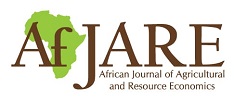Optimal land resource allocation for tree crop enterprises among farmers in the eastern region of Ghana: A target MOTAD linear programming analysis
Agbenyegah Kwami Horgli, Akwasi Mensah-Bonsu & Samuel Adjei-Nsiah
Abstract
This paper examines the optimal land resource allocation for tree crop enterprises in the Eastern region of Ghana based on data collected from sampled cocoa, oil palm, and rubber farmers. The estimated net present value (NPV) and benefit-cost ratio (BCR) revealed that cocoa production was the most profitable and rubber production the least profitable. The target MOTAD linear programming (LP) profit-maximising enterprise combination allocated 73.9% and 26.1% of the average land to cocoa and oil palm production, respectively, and nothing to rubber, with an NPV of USD 262.70/ha. However, sensitivity analysis revealed that highly risk-averse farmers would cultivate more oil palm and rubber and less cocoa. In a high production-risk environment, efforts to sustain cocoa production would require more deliberate policy initiatives to support cocoa farmers. Alternative policies to promote and expand other tree crops, particularly rubber, should also tackle the associated risk factors.
